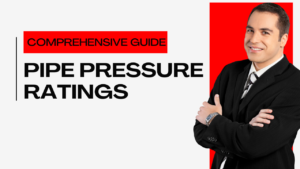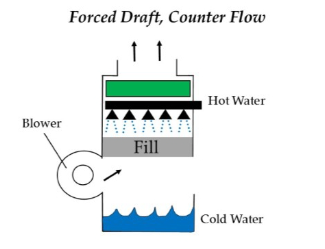
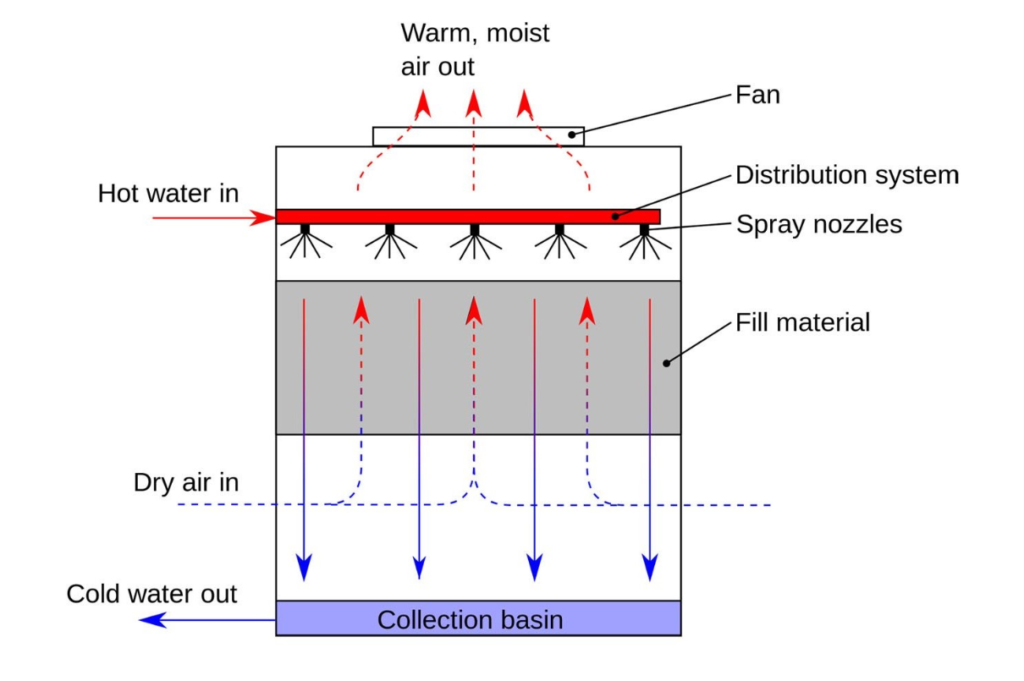
1. Crossflow Cooling Tower Airflow: Crossflow vs. Counterflow Cooling Towers
How does airflow occur in crossflow cooling towers?
Explanation: In crossflow cooling towers, airflow occurs horizontally through the fill media and tower structure, meeting hot water cascading downwards.
2. Counterflow Cooling Tower Advantages
What is an advantage of counterflow cooling towers?
Explanation: An advantage of counterflow cooling towers is higher cooling efficiency compared to crossflow towers.
3. Crossflow Cooling Tower Disadvantages
What is a disadvantage of crossflow cooling towers?
Explanation: A disadvantage of crossflow cooling towers is lower cooling efficiency compared to counterflow towers.
4. Choosing the Right Design
What should be considered when choosing between crossflow and counterflow cooling towers?
Explanation: The best choice depends on factors such as required cooling capacity, budget, and maintenance requirements. Therefore, the correct answer is “D) All of the above.”
5. Counterflow Towers in Cold Climates
Which type of cooling tower is better suited for cold climates?
Explanation: Counterflow towers are better suited for cold climates due to being less prone to icing.
6. Energy Efficiency in Cooling Towers
How can counterflow towers contribute to energy efficiency?
Explanation: Counterflow towers can contribute to energy efficiency due to lower pump head requirements.
7. Conclusion on Cooling Towers
What is the key takeaway regarding the choice between crossflow and counterflow cooling towers?
Explanation: Both crossflow and counterflow cooling towers have their strengths and weaknesses, and the choice depends on specific needs and priorities.
Don’t miss the following related topics on Cooling Towers
Short Article on Crossflow vs. Counterflow Cooling Towers
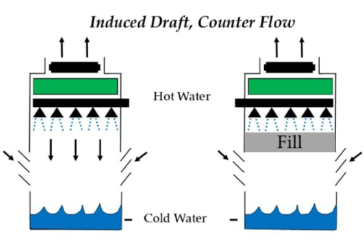
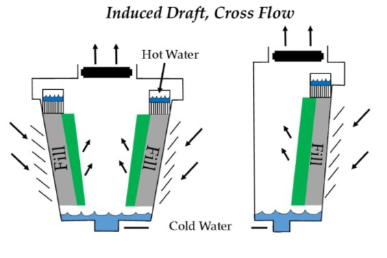
Choosing the Right Flow: Crossflow vs. Counterflow Cooling Towers
Industrial processes often require efficient cooling, which is where cooling towers come in. Two main types of cooling tower designs exist: crossflow and counterflow. Each offers distinct advantages and disadvantages, making it crucial to understand the differences when choosing the right system for your needs.
Crossflow Cooling Towers:
- Airflow: Air flows horizontally through the fill media and tower structure, meeting hot water cascading downwards.
- Advantages:
- Simpler design, often less expensive.
- Lower maintenance requirements.
- More forgiving in off-design conditions.
- Disadvantages:
- Lower cooling efficiency than counterflow towers.
- Prone to icing in cold weather, requiring additional weather-proofing.
- Higher pump head requirements due to water flow direction.
Counterflow Cooling Towers:
- Airflow: Air moves vertically upwards, counter-current to the hot water falling downwards.
- Advantages:
- Higher cooling efficiency compared to crossflow towers.
- Less prone to icing due to counter-current flow.
- Lower pump head requirements.
- Disadvantages:
- More complex design, potentially higher initial cost.
- Requires more precise control of airflow and water distribution.
- More sensitive to off-design conditions.
Choosing the Right Design:
The best choice between crossflow and counterflow cooling towers depends on your specific needs and priorities. Consider the following factors:
- Required cooling capacity: Counterflow towers excel in this aspect.
- Budget: Crossflow towers are generally cheaper.
- Maintenance requirements: Crossflow towers are simpler to maintain.
- Climate: Counterflow towers are better in cold climates.
- Energy efficiency: Counterflow towers can save energy due to lower pump head requirements.
Conclusion:
Both crossflow and counterflow cooling towers have their strengths and weaknesses. By understanding their key differences and considering your specific needs, you can make an informed decision about the best type of cooling tower for your application.
Table of Contents
Don’t miss the Course on Effective Isometrics Management: Check Now
Enrollment Link
Recommended courses (Published on EPCLand)
- Complete Course on Piping Engineering
- Basics of Piping Engineering
- Piping Layout Engineering
- Piping Material Engineering
- Piping Stress Analysis
- Material Requisitions
- Piping Material Specifications
- Valve Material Specifications
- Plant Design & Layouts-OISD 118
- Isometric Management
Library of Technical Articles
Don’t miss out the collection of 15+ articles on following topics:
- Basics of Oil and Gas Industry
- Valves
- Testing
- Tank
- Piping Bulk Items
- Pipe
- Metallurgy
- Piping Materials
- Layout
- Instrumentation
- Heat Exchanger
- Type of Contracts
- Codes and Standards
- ASTM Standards
- Articles on Piping Specialty Items
Video details of Complete Course on Piping Engineering
Why Enroll in the EPCLand
Proven Track Record– PTR
Activities & Achievements before launching EPCLand
- Published more than 50+ short courses
- 3000+ Enrolments
- More than 3,500,00 Minutes of watch hours in the last 2 years
- 4000+ Students in 100+ Countries
- Rating of 4+ out of 5
- 1000+ YouTube Videos
- 8K+ Subscribers
What Students will Learn
- Codes & Standards of the Energy Sector
- Piping Material Engineering
- Piping Layout Engineering
- Stress Analysis
Interesting facts
- All the published courses have been developed by Industry Experts with more than 2 decades of experience
- Content is based on Practical experience and real-time problems.
- Content is designed and organized in such a manner that it can be easily grabbed.
- Complete website, Blogs and Quiz sections are Planned, Designed and published by myself (About me: Atul Singla)
- Complete flexibility of Time & Location, Students can access the content from anywhere & anytime
- Moreover, once enrolled, the content can be access as many times as you want, which helps in understand the fundamentals in a better way.
Conclusion
In conclusion, our courses are meticulously crafted by industry experts with over two decades of hands-on experience. The content is rooted in practical knowledge, addressing real-time problems. The material is thoughtfully designed and organized for easy comprehension. Every aspect, from the website to blogs and quizzes, has been planned, designed, and executed by Atul Singla, ensuring a comprehensive and seamless learning experience. With the flexibility of accessing the content at any time and from any location, students have the freedom to learn on their terms. Furthermore, enrollment grants unlimited access, allowing learners to revisit the material as often as needed, fostering a deep understanding of the fundamentals.



